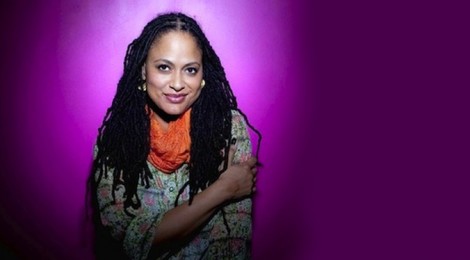Ava Duvernay’s MIDDLE OF NOWHERE
I was thrilled when I read last night that MIDDLE OF NOWHERE was the #1 debut at the box office this weekend for indie films and, averaging $13,000 per screen, it had the biggest per-screen total for any film currently in theaters (even making twice the per screen figures of both Taken and Argo). This is major and no doubt a direct result of Ava Duvernay’s refusal to fail mixed with her massive grassroots campaigning and I’m sure, the nod from Oprah didn’t hurt either.
I also know this type of momentum has to continue to surge for what I feel is a MUST SEE film. Let me get straight to the point. We, yes WE, need to continuously support Black independent filmmaking– smart, cutting-edge, beautiful Black independent filmmaking– like we support Jay-Z and Beyonce when they’re on tour. All eight of Hov’s shows were sold-out at Barclays in Brooklyn last week. I know people who went more than once. We need to have that same kind of mind-set and enthusiasm when it comes to independent films that give nuanced, complex, non-stereotypical performances of Black folk. This means we go opening weekend and we tell a friend or 10 and make sure they buy tickets for the following week’s screenings. If we can give our loot to Jigga and Barclays then surely we can support Ava and Spike.
I’ll never forget going to see “Rosewood” one Saturday night in 1997. It was the following weekend after the opening of what was John Singleton’s fourth film. The movie portrayed the horrific and rarely spoken about story of self-sufficient Black folk who ran their own town and how one lie led to the destruction of Rosewood and to the murders and lynchings of so many of its residents by racist whites. I was amped for John Singleton. He was breaking out of his typical urban-themed movie mold to tackle real-life Black history. This was going to be huge! Rosewood had gotten a number of great reviews and with two “Boyz In The Hood” Oscar noms under his belt, Singleton had successfully secured 30 milly from Warner Bros. Needless to say, I was stunned to see the theater only half-full. “Where the heck was everyone,” I wondered aloud. When I walked out of the theater– totally shook, but so impressed with Singleton’s retelling, I was confronted with lines, nah let me keep it real, there were throngs of people, Black people, waiting to see “Booty Call” (opening that same weekend). I was too through! When the dust settled and the numbers came out “Rosewood” made a measly $13M. “Booty Call,” made for only $7M grossed over $20M. Filmmaking for Black folk would never be the same.
Fast forward 15 years and Black independent filmmakers are making major strides to go beyond moments of success to a movement of success. Not seen since the early-mid 90’s, there’s a current influx of Black independent filmmakers that, like the town of Rosewood, are self-sufficient, self-loving and self-contained. This movement is led by Ava via her African American Film Festival Releasing Movement (AFFRM) who believes: “Men of a certain hue and certain age have an incredible amount of power and capital from doing the same thing over and over, and this doesn’t include nuanced portrayals of the inner life of women. That’s not part of their business model. At some point we have to ask, ‘Why am I knocking on this door asking you to do something for me, when I can go build my own door and do my own thing?’”
One of my favorite scenes from “Hustle & Flow” was near the end when Djay gets locked-up and Key pays him a visit and lets him know that he’s not the only one living in a prison:
“Talk about eternity, man. (We) locked up, just like you. But ain’t no sorrow gonna take away Shug’s song. Let me tell you that. That woman, she got love for you. So when you talk about eternity… you think about your woman.”
The idea that Djay’s incarceration also leads to the sudden emotional imprisonment of his entire crew including, and especially, his woman was mind-blowing and riveting. I wanted to know more about how Shug was maintaining, but I was left with rolling credits. Now, the winner of the Best Director Award at the 2012 Sundance Film Festival, MIDDLE OF NOWHERE picks up on this eye-opening, very real, but unspoken dilemma. Instead of Shug, we follow Ruby, “a bright medical student who sets aside her dreams and suspends her career when her husband is incarcerated. As the committed couple stares into the hollow end of an eight-year prison sentence, Ruby must learn to live another life, one marked by shame and separation.”
I saw the movie Saturday morning and can attest that it’s all that and a large box of popcorn. I love MON because it’s not about life in prison. If you want that then NetFlix “OZ.” Instead of taking viewers inside cellblocks, Ava lets us linger in the prison waiting rooms and at bus stops and in parole hearings with the families of those who are incarcerated. She serves up a mighty bleak, yet complicated, passionate version of prison life for many women who aren’t physically behind bars, but whose lives are bound in emotional prisons because they love men who are in jail. It’s “Love Jones” under Rockefeller Law. Unlike LJ the poetry is not so much in the spoken word as it is in the glances, stares and deafening silence. See this movie and you’ll see what I mean.








“Love Jones Under Rockefeller Law”–now that beautiful people is how you summarize a great flick. I stopped reading at that point because I really want to see this film with no reviews in hand. Thanks as always for putting it down:)
Thank you!!!